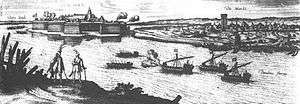Šajkaši
| Šajkaši | |
|---|---|
| Tschaikisten (German) | |
| Active | 1475–1804 |
| Allegiance |
|
| Branch | River Flottila |
| Role | Defence of Danube and Sava |
| Colors | Blue |
šajkaši (In Serbian, Serbian Cyrillic: шајкаши, German: Tschaikisten) refers to the river flottila troops guarding the Danube and Sava, and especially, the Port of Belgrade, against the Ottoman Empire from the 16th to the 19th century. During that period, the rivers were natural borders of the Kingdom of Hungary and Habsburg Monarchy with the Ottoman Empire, part of the Military Frontier. The troops were composed out of ethnic Serbs, who had special military status. Their name derives from the small wooden boat known as chaika (šajka, tschaiken), a type of galley.
Organization
Personal armament
The Šajkaši were armed with sabres, spears and ordinary and mechanical arrows. Sometimes they wore helmets and shields. Their spears likely were longer than ordinary, set to be used at longer distances.[1] They used arrows until the end of the 16th century when the arquebus had been perfected.[1] Later, when gunpowder began to be widely used, the Šajkaši were armed with sabres, long spears and muskets.[1]
Warship armament
- Late 15th and 16th century
In 1475, King Matthias had in his Danube Flotilla around 330 chaika with 10,000 men, among which were 1,700 lancers, 1,200 men-at-arms, while "the rest were catapultists and crossbowers".[1] In the Belgrade port, 34 chaika with 18 oars, 18 soldiers and a catapult at the front were stationed.[1] Larger chaika, of which there were 16, had 24 oars and 300-man-crew, 4 large guns at the front, "from which 100-pounds of weight of shots, 100 carbott or pisside (types of shells), and 200 hand-guns, were shot".[1] Apart from the ordinary chaika, there were larger ones, called "galleys".[1]
Clothing
Their clothing was in dark-blue colour.[1]
Ranks
- Hungary, 16th century
- The supreme commanders of Šajkaši commands in Hungarian service were called vajd (from vojvoda).[2] These were usually selected – retired Šajkaši would choose four candidates, of which the captain would chose one for the command.[2] There were instances when the vajd was appointed, but this right, it seems, was only held by the monarch.[2] The vajd stayed in his position until death.[2] The number of vajds was never determined, and it varied depending on the sizes of the Šajkaši crews.[2] There were usually 20–40.[2] In 1521, in Belgrade, there were only 3, while in Varadin 7, and in Slankamen 5.[2] In 1537, there were 17 vajds in Komárom, down to 7 in 1546.[2] The vajd usually served at one place, but there were instances when he was transferred.[2]
History
16th century

Pavle Bakić commanded the Šajkaši in the service of Ferdinand, the Archduke of Austria and King of Hungary and Croatia. The Šajkaši participated in the Battle of Mohács (1526). After the battle the Šajkaši were still unpaid for their services. Ferdinand reprimanded the court for not having paid at least part of the unpaid salary to the Šajkaši.[3] Bakić once again turned to Ferdinand, alerting him that the nonpayment to the Šajkaši would cause estrangement of the Serbs in his lands, and those of Zapolya and the Ottoman Empire.[3] He also informed Ferdinand of the persecution of Serbs by the Austrian staff and officers.[3]
Šajkaši migrations
Šajkaši families, Serbs, settled in Esztergom during the rule of Matthias Corvinus, a settlement in the lower town developed from the community, called Srpska varoš.[4]
A group of Serbian Šajkaši settled in Slovakia, where they continued their service, known in Slovak as čajkári.
Legacy
In Hungarian war annals the most clear and also most vulnerable place is taken by the King's Šajkaši. They were the most important factors and participants of the victories of the Royal Army. Whenever there was a threat to Hungary, the Šajkaši were the main support of the territorial defence and the most reliable aid to the Royal Army.[5]
Stationed at many locations, the most important Šajkaši units were those of Komárom, as this was the most important Imperial fortress in Hungary; they were stationed here up until the reign of Maria Theresa, when they were moved to South Bačka.[6]
The šajkača hat is derived from the 18th-century Šajkaši in Banat.
See also
- Šajkaška, a region named after the military unit
- Šajkaš, a village named after the military unit
- Serbian Militia
- Serbian Free Corps
Annotations
Another term used in German was Nassadisten (Serbian: насадисте/nasadiste).
References
- 1 2 3 4 5 6 7 8 Popović 1990, p. 190.
- 1 2 3 4 5 6 7 8 9 Kolundžija 2008, p. 236.
- 1 2 3 Kolundžija 2008, p. 184.
- ↑ Bulletin scientifique. 24. Le Conseil. 1988. p. 90.
- ↑ Српско учено друштво (1887). Гласник Српскога ученог друштва. 67. p. 2.
- ↑ Srpsko učeno društvo (1871). Glasnik Srpskoga učenog društva. 30-32. pp. 91–.
Sources
- Kolundžija, Zoran (2008). Vojvodina: Od najstarijih vremena do velike seobe. Prometej.
- Popović, Dušan J. (1990). Srbi u Vojvodini. 1. Matica srpska.
- Samardžić, Radovan; Veselinović, Rajko L.; Popović, Toma (1993). Radovan Samardžić, ed. Istorija srpskog naroda. Treća knjiga, prvi tom: Srbi pod tuđinskom vlašću 1537-1699. Belgrade: Srpska književna zadruga.